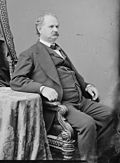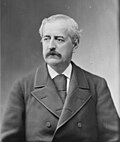| Delegate | Party | Years | Cong
ress | Electoral history |
|---|
| District created in 1864 |

Charles Debrille Poston
(Tubac) | Republican | December 5, 1864 –
March 3, 1865 | 38th | Elected in 1864.
Lost re-election. |
| Vacant | March 4, 1865 –
January 17, 1866 | 39th | Election was held late and Goodwin took months to arrive in Washington. |

John Noble Goodwin
(Prescott) | Republican | January 17, 1866 –
March 3, 1867 | Elected September 6, 1865. [4]
Retired. |

Coles Bashford
(Tucson) | Independent | March 4, 1867 –
March 3, 1869 | 40th | Elected in 1866.
Retired to become Secretary of State of Arizona Territory. |

Richard C. McCormick
(Tucson) | Unionist | March 4, 1869 –
March 3, 1875 | 41st
42nd
43rd | Elected June 3, 1868.
Re-elected November 8, 1870.
Re-elected November 8, 1872. [9]
Retired. |

Hiram Sanford Stevens
(Tucson) | Democratic | March 4, 1875 –
March 3, 1879 | 44th
45th | Elected in 1874. [10]
Re-elected in 1876.
Lost re-election. |
John G. Campbell
(Prescott) | Democratic | March 4, 1879 –
March 3, 1881 | 46th | Elected in 1878.
Retired. |

G. H. Oury
(Florence) | Democratic | March 4, 1881 –
March 3, 1885 | 47th
48th | Elected in 1880.
Re-elected in 1882.
Retired. |
Curtis Coe Bean
(Prescott) | Republican | March 4, 1885 –
March 3, 1887 | 49th | Elected in 1884.
Lost re-election. |

Marcus A. Smith
(Tombstone) | Democratic | March 4, 1887 –
March 3, 1895 | 50th
51st
52nd
53rd | Elected in 1886.
Re-elected in 1888.
Re-elected in 1890.
Re-elected in 1892.
Lost re-election. |

Oakes Murphy
(Phoenix) | Republican | March 4, 1895 –
March 3, 1897 | 54th | Elected in 1894.
Retired. |

Marcus A. Smith
(Tucson) | Democratic | March 4, 1897 –
March 3, 1899 | 55th | Elected in 1896.
Retired. |
John Frank Wilson
(Prescott) | Democratic | March 4, 1899 –
March 3, 1901 | 56th | Elected in 1898.
Retired. |

Marcus A. Smith
(Tucson) | Democratic | March 4, 1901 –
March 3, 1903 | 57th | Elected in 1900.
Retired. |
John Frank Wilson
(Prescott) | Democratic | March 4, 1903 –
March 3, 1905 | 58th | Elected in 1902.
Retired. |

Marcus A. Smith
(Tucson) | Democratic | March 4, 1905 –
March 3, 1909 | 59th
60th | Elected in 1904. Re-elected in 1906.
Lost re-election. |

Ralph H. Cameron
(Flagstaff) | Republican | March 4, 1909 –
February 18, 1912 | 61st
62nd | Re-elected in 1908.
Served until statehood. |
| District eliminated in 1912 |